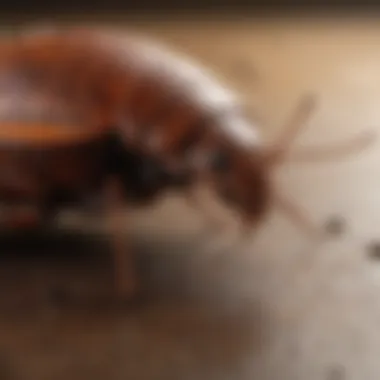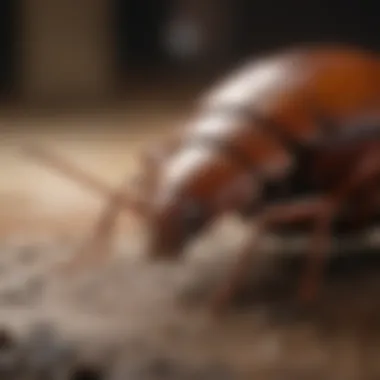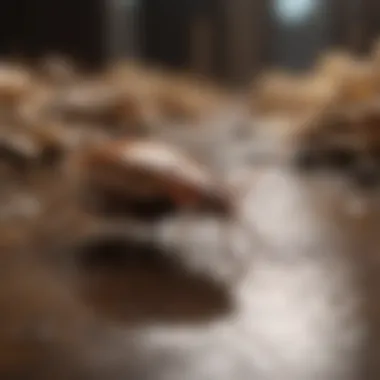The Efficacy of Boric Acid in Controlling Cockroaches


Intro
The use of boric acid for controlling cockroach populations has gained attention among pest control professionals and homeowners alike. As an effective insecticide, boric acid operates through a unique mechanism that makes it a viable alternative to traditional methods. This document explores its efficacy, application methods, safety concerns, and environmental implications. Understanding these factors is crucial for informed pest management decisions.
Fascinating Facts About the Animal
Unique Characteristics
Cockroaches are resilient creatures, known for their adaptability. They possess a flattened body shape, enabling them to navigate through small crevices. With over 4,000 species, few are deemed pests. The German cockroach and the American cockroach are among the most common species in urban environments.
Extraordinary Abilities
Cockroaches can survive without food for a month, and without water for up to a week. Their ability to endure various conditions makes them particularly challenging to eradicate. They are also capable of producing offspring rapidly, which can complicate pest control efforts.
Behavior and Habitat
Natural Habitats
Cockroaches thrive in warm, humid environments. They often seek shelter in kitchens and bathrooms, where food and moisture are abundant. However, they can also adapt to different environments, making them a common sight in homes and commercial buildings.
Social Structures
Cockroaches display social behavior, living in groups or colonies. They communicate through pheromones, which facilitate social interaction. This behavior enhances their chances of survival by sharing information about food sources and potential threats.
Recent Scientific Discoveries
Latest Research Findings
Recent studies have focused on the effectiveness of boric acid as a cockroach control method. Research indicates that boric acid disrupts the cockroach's digestive system after ingestion, ultimately leading to dehydration and death.
Breakthroughs in Animal Biology
Advancements in understanding cockroach biology, such as their resistance mechanisms, highlight the importance of targeted pest control strategies. Research suggests that integrating boric acid with other methods could yield better results in managing infestations.
Cultural Significance
Animals in Folklore
In various cultures, cockroaches are often seen as symbols of resilience. While some view them negatively, others celebrate their endurance as a testament to survival against odds.
Influence on Art and Literature
Cockroaches have found their way into literature and art, where they sometimes symbolize decay or the darker aspects of society. Their portrayal often reflects the human relationship with pests and the inherent struggles of coexistence.
Boric acid has been recognized not only for its efficacy in pest control but also for its relative safety when used according to guidelines, making it a preferred choice for many homeowners.
Understanding Cockroaches
Understanding cockroaches is essential for effective pest control strategies, especially when considering the use of boric acid. These insects are resilient and can adapt to many environments, making them a persistent problem in households and commercial spaces. Recognizing their species, behaviors, and habitat preferences can significantly enhance control efforts.
Species Overview
Cockroaches belong to the order Blattodea, with over 4,600 species identified. However, only a few species are notorious pests. The German cockroach, for instance, is a common household pest, known for its rapid reproduction. Another notable species is the American cockroach, which prefers warmer, more humid environments. Understanding these species helps tailor control measures effectively, as different species may respond variably to treatments like boric acid.
Behavioral Traits
Cockroaches exhibit fascinating behavioral traits. They are primarily nocturnal, leading them to forage for food at night. They have strong olfactory senses that aid in locating food sources. When threatened, they can exhibit rapid movements, making them challenging to catch. These behaviors inform control strategies, as they may be less likely to come into contact with bait during daylight hours. Effective boric acid treatments must consider these behavioral patterns to enhance efficiency.
Habitat Preferences
Cockroaches thrive in environments that offer warmth, moisture, and food sources. Common habitats include kitchens, bathrooms, and basements, where they often hide in crevices and cracks. These preferences are critical when deploying control measures. Boric acid, for example, is most effective when applied in areas where cockroaches are likely to travel. By understanding their habitat needs, pest control efforts can be more targeted, increasing the likelihood of successful extermination.
Prologue to Boric Acid


The use of boric acid in pest control is an essential topic in the management of cockroach populations. Understanding its application provides valuable insight for homeowners and pest management professionals alike. Boric acid is not only effective, but it also presents a safer alternative to many chemical insecticides. This section explores its chemical properties and historical usage, which are foundational for understanding the role it plays in effective pest control.
Chemical Properties
Boric acid, with the chemical formula H₃BO₃, is a weak acid that exhibits unique qualities which make it effective against cockroaches. Its crystalline structure allows it to be used in various formulations. When ingested, boric acid disrupts the cockroach’s digestive system and neurological function, leading to dehydration and death.
- Low Toxicity: Boric acid has low toxicity levels to humans and pets when used as directed. This makes it an appealing option for households.
- Absorption: Cockroaches efficiently absorb boric acid through their exoskeleton and during grooming, enhancing its effectiveness.
- Environmental Stability: Boric acid is stable in the environment, meaning it will not break down quickly and can be effective for extended periods.
These properties highlight why boric acid is considered a go-to solution in pest control, particularly for cockroaches.
Historical Usage
The use of boric acid can be traced back to the 19th century when it first gained popularity for its antiseptic and insecticidal properties. Its application in pest control is well documented over the years.
- Early Applications: Initially used in medicine, it was soon recognized for its efficiency in controlling pest populations, particularly in urban settings.
- Recognition: Over the decades, various studies have validated its effectiveness against cockroaches, leading to its widespread adoption in both residential and commercial spaces.
- Modern Formulations: Today's formulations include boric acid dusts and baits, specifically designed for targeted application in pest management.
The historical context of boric acid demonstrates its evolution and ongoing relevance in pest control strategies. Understanding this history is crucial as it provides insight into its capabilities and the potential for further research and adaptation in pest management practices.
Mechanisms of Action
Understanding the mechanisms of action for boric acid in cockroach control is fundamental for effective pest management. This section explores how boric acid acts as an insecticide and its implications for targeting cockroach physiology.
Insecticidal Properties
Boric acid is not a conventional insecticide. Its effectiveness lies in its unique method of action. When cockroaches come into contact with boric acid, it adheres to their exoskeleton. Upon grooming, the cockroach ingests the boric acid, which disrupts their digestive system.
Additionally, it acts on the cockroach’s metabolic processes. Boric acid interferes with their ability to function normally. Over time, this leads to dehydration and death. This dual mechanism of contact and ingestion enhances the efficacy of boric acid, allowing it to target cockroaches even if they do not directly consume it.
A few key points about insecticidal properties of boric acid include:
- It is less toxic to humans and pets compared to chemical insecticides.
- The compound is effective against various cockroach species.
- It disrupts cockroach reproduction, affecting population management over time.
Boric acid offers a sustainable solution in pest control by reducing reliance on stronger chemicals.
Impact on Cockroach Physiology
The impact of boric acid on cockroach physiology is multifaceted. Once ingested, boric acid alters essential bodily functions. It affects the nervous system and impairs energy metabolism. This is significant because the physiological disruption leads to a decline in the cockroach's ability to move and function.
Moreover, damage to their digestive system prolongs distress before death. This delayed effect ensures that the cockroach could spread boric acid to others in its colony, amplifying its effectiveness as a control method.
Key impacts on cockroach physiology include:
- Dehydration: Loss of water regulation can be critical, leading to quicker mortality.
- Reduced Mobility: Affected cockroaches may struggle to move, making them more vulnerable.
- Disruption of Reproduction: Physiological changes can result in lower reproductive success, impacting population levels over time.
The interplay of these factors reveals why boric acid is considered a valuable component in integrated pest management strategies. Its ability to act effectively while posing less risk to non-target organisms positions boric acid as a favorable option for both home and professional pest control efforts.
Effectiveness of Boric Acid
The effectiveness of boric acid in controlling cockroach populations is a key topic in pest management. Boric acid is well-regarded for its insecticidal properties and has long been used as a reliable method for pest control. Understanding its effectiveness can guide homeowners and pest control professionals in making informed decisions about cockroach management strategies.
Field Studies
Field studies provide an empirical foundation for evaluating the effectiveness of boric acid. Numerous trials conducted in various environments, like residential buildings and commercial spaces, have highlighted its ability to significantly reduce cockroach populations. This reduction is often measured by tracking the number of cockroaches seen over time.
Research indicates that when boric acid is applied in suitable locations, it can lead to a notable decrease in both adult and juvenile cockroaches. A study performed in urban environments showed that boric acid application resulted in an 80% reduction in cockroach sightings within a month. Particularly effective areas included places where cockroaches usually hide, such as under sinks and behind appliances.
Another advantage noted in field studies is the prolonged effectiveness of boric acid. Unlike some insecticides that become less effective quickly, boric acid remains potent for extended periods. It works by desiccating the cockroach once ingested, leading to a slow and effective elimination process. Studies observed that boric acid left undisturbed in cracks and crevices showed continued effectiveness for several months.
Comparative Analysis with Other Methods
A comparative analysis of boric acid with other pest control methods is essential for understanding its unique benefits. Traditional chemical insecticides, for instance, often cause rapid cockroach mortality but may also pose health risks to humans and pets. In contrast, boric acid’s mode of action is less harmful to the environment and users.
When compared to bait traps, boric acid demonstrates advantages in terms of cost and efficiency. Baits can attract other non-target insects, potentially affecting the local ecosystem. Boric acid, however, does not draw attention from creatures other than cockroaches.
When evaluating integrated pest management strategies, boric acid synergizes well with environmental modifications. For example, sealing entry points and reducing food availability can enhance its effectiveness. This collaborative effort contrasts with methods that rely solely on chemical applications, which may not address the underlying causes of infestations.


“The use of boric acid reflects a balanced approach to pest control, prioritizing safety and effectiveness.”
Application Methods
Application methods are crucial in maximizing the effectiveness of boric acid in cockroach control. Proper application ensures that boric acid reaches the target areas where cockroaches are likely to inhabit. Moreover, choosing the right method can lead to improved safety for humans and pets, minimizing risks while optimizing pest management results. Understanding these methodologies allows both homeowners and pest control professionals to utilize boric acid in a more strategic manner.
Dusting Techniques
Dusting is a well-recognized method for applying boric acid. This approach involves using a dust applicator to spread the fine powder in areas prone to cockroach activity, such as cracks, crevices, and around entry points. An important benefit of dusting is that it allows for targeted application. The fine texture of the powder clings to surfaces easily and is readily accessible to cockroaches.
When conducting dusting, it is crucial to ensure that the product settles into the desired locations. One must avoid over-application, as excessive dust can lead to waste and reduce effectiveness. Additionally, safety must always be considered. Dust application should only be performed in areas where children and pets cannot easily access, ensuring minimal exposure.
Some points to keep in mind while using dusting techniques include:
- Use appropriate dust applicators: Smaller applicators provide precision when distributing the boric acid.
- Keep the area dry: Boric acid is most effective in dry environments; moisture can diminish its efficacy.
Boric Acid Baits
Boric acid baits combine the insecticidal properties of boric acid with attractive food substances that entice cockroaches. The cockroaches consume the bait, and the boric acid acts as a slow-acting poison that disrupts their digestive systems. This approach not only eliminates those who ingest the bait but may also lead to secondary kill, as the poison can be transferred to other cockroaches through interactions in their habitat.
Setting up boric acid bait stations requires strategic placement. Areas such as under sinks, behind appliances, and near garbage bins are prime locations for bait deployment. Regular monitoring of the bait stations is recommended, as the bait may need replenishing. Bouric acid baits are particularly appealing due to their higher degree of safety for humans and pets, provided they are used judiciously.
It is important to consider:
- Choose the right attractant: Different cockroach species may gravitate toward different food sources.
- Avoid placing baits in open areas: This reduces the likelihood of accidental ingestion by non-target animals.
Spray Solutions
Spray solutions of boric acid are another method for cockroach control. While less common than dusting and baiting, they serve a purpose in certain applications. Typically, boric acid is mixed with water and sprayed on surfaces where cockroaches may linger. This method provides immediate coverage and can be effective in areas with heavy infestations.
When using spray solutions, the application should be targeted and thorough. A fine mist is preferred to ensure that the solution penetrates crevices and hides effectively. It is important to remember that spray methods may leave residues, so surfaces should be monitored for possible buildup.
Some guidelines while applying spray solutions include:
- Use personal protective equipment: This helps to safeguard against inhalation or skin contact.
- Allow surfaces to dry completely: This ensures the effectiveness of the product as it develops its insecticidal action.
Proper boric acid application methods can greatly improve the chances of effective cockroach control, enhancing both safety and efficacy.
In summary, the selection of an application method greatly influences the outcome of boric acid use in cockroach control. Dusting, baiting, and spraying each offer distinct advantages and considerations which should be aligned with specific infestation scenarios and environmental factors.
Safety Considerations
The use of boric acid as an insecticide requires careful attention to safety concerns. Understanding the potential risks helps mitigate health hazards for both humans and pets. This section will address two significant aspects: health risks and safe handling practices.
Health Risks for Humans and Pets
Boric acid is considered less toxic compared to many chemical insecticides, but this does not mean it is entirely safe. Ingesting significant amounts can lead to severe health issues. For instance, if humans or pets consume boric acid, symptoms include nausea, vomiting, and abdominal pain. These symptoms occur because boric acid disrupts cellular processes.
It is essential to note that pets, particularly cats and dogs, may be more susceptible to its effects than humans. Cats, in particular, can experience complications even with minimal exposure. Therefore, precautions should be in place to limit their access to treated areas.
Some long-term exposure risks exist as well. Research indicates that high levels of boric acid can cause skin irritation for some individuals.
Key Points to Consider:
- Keep products out of reach: Store all boric acid in secure containers away from children and pets.
- Follow instructions precisely: When applying boric acid, adhere to the recommended guidelines to prevent accidental exposure.
- Monitor for symptoms: Be observant for any health issues arising from exposure, including lethargy in pets or skin reactions in humans.
Safe Handling Practices
Handling boric acid safely is crucial to prevent accidental ingestion and exposure. When applying boric acid, always use personal protective equipment, such as gloves and masks, to minimize direct contact with the substance. If you are dealing with larger quantities, consider goggles to protect your eyes.
Moreover, following these guidelines will enhance safety:
- Use in well-ventilated areas: Ensure spaces are adequately ventilated to avoid inhaling any dust, especially during the application process.
- Clean up spills promptly: Accidental spills can pose a risk to both humans and pets. Using a damp cloth or paper towel to clean up is advisable.
- Store correctly: Boric acid should be in labeled containers, sealed tightly to prevent accidental opening.
“Understanding and practicing safe handling is as essential as the efficacy of the product itself.”


By following these safety considerations, the risks associated with boric acid can be managed effectively, ensuring a safer environment for both human and pet inhabitants while pursuing cockroach control methods.
Environmental Impact
Understanding the environmental impact of using boric acid for cockroach control is essential. This article discusses how boric acid interacts with ecological systems and the regulatory frameworks that shape its application.
Ecological Considerations
Boric acid is a compound that raises several ecological considerations when utilized as an insecticide. First, its low toxicity to non-target organisms makes it a preferred choice in pest management. This means that wildlife, beneficial insects, and aquatic systems are less likely to be adversely affected compared to more potent chemical insecticides. When applied correctly, boric acid has minimal persistence in the environment, which prevents long-term accumulation.
Moreover, studies have shown that boric acid can act as a deterrent without extensive collateral damage to ecosystems. However, it is still prudent to ensure that it does not contaminate water sources or soil. Regular monitoring is advisable. Furthermore, minimizing contact with desirable species is crucial in preserving biodiversity.
To summarize:
- Low toxicity: Boric acid is safer for non-target organisms.
- Minimal persistence: It does not accumulate to harmful levels.
- Biodiversity: Careful application can help maintain ecological balance.
Regulatory Aspects
Regulatory aspects concerning boric acid are important for ensuring its safe usage. Different countries have specific guidelines regarding its application. In the United States, for instance, the Environmental Protection Agency (EPA) oversees its registration. Boric acid is classified as a low-risk pesticide, which grants it relatively straightforward approval pathways. However, it is crucial to follow label instructions to comply with safety regulations.
Additionally, some jurisdictions may have restrictions on the concentration of boric acid that can be used. Keeping track of such regulations helps avoid unauthorized use and promotes responsible handling.
Regulatory highlights include:
- Registration: Boric acid is regulated by authorities like the EPA.
- Usage guidelines: It is essential to adhere to the specified concentrations.
- Region-specific: Various jurisdictions may impose unique restrictions.
Effective environmental management relies on understanding both the ecological implications and regulatory requirements of using chemical compounds like boric acid.
Alternatives to Boric Acid
Exploring alternatives to boric acid is essential for a more rounded approach to cockroach control. With multiple options available, understanding the benefits and drawbacks of these alternatives can lead to more effective pest management strategies. Homeowners and pest control professionals may consider various methods based on effectiveness, safety, and environmental impact.
Natural Remedies
Natural remedies have gained attention as alternatives to synthetic chemicals. They are often perceived as safer and more environmentally friendly. Some common natural solutions include:
- Diatomaceous Earth: This substance damages the exoskeleton of cockroaches, leading to dehydration and death. It is important to apply it in areas where cockroaches frequent.
- Essential Oils: Oils like peppermint and tea tree are noted for their insect-repelling properties. While not as potent as chemical solutions, they can create an unpleasant environment for cockroaches.
- Soap and Water Solutions: Mixing soap with water can suffocate cockroaches upon contact. This method is relatively safe and easy to use, but it requires direct application on the insects.
These remedies, while less aggressive, often require persistence and may take longer to show results compared to chemical solutions.
Chemical Insecticides
Chemical insecticides remain a common choice for immediate control. They are formulated to target insect systems directly and can provide quick results. Notable examples include:
- Pyrethroids: These chemicals are derived from chrysanthemum flowers. They function by disrupting the nervous system of insects, leading to paralysis and death. While effective, caution is needed as they may also harm beneficial insects.
- Organophosphates: These are another class of chemical insecticides that inhibit essential enzymes in insect bodies. However, they pose higher toxicity risks to humans and pets, necessitating careful application and usage following safety guidelines.
- Neonicotinoids: This class affects the central nervous system of insects. Neonicotinoids are effective but have raised concerns about ecosystem impacts, particularly on pollinators.
Chemical insecticides can provide quick elimination but may require repeated applications and careful handling to avoid health hazards to humans and pets.
Integrated Pest Management Strategies
Integrated Pest Management (IPM) is a holistic approach that combines multiple strategies for effective pest control. Key components of IPM include:
- Preventative Measures: Regular cleaning, sealing entry points, and reducing food and water sources can decrease pest populations significantly.
- Monitoring and Assessment: Identifying and monitoring cockroach populations helps determine the most effective control methods, whether natural or chemical.
- Targeted Treatments: Using specific treatments when necessary, rather than blanket applications, minimizes chemical use while maximizing efficacy.
- Community Collaboration: Engaging neighbors and local groups can be beneficial in managing cockroach problems on a larger scale.
Adopting an IPM strategy promotes long-term solutions while minimizing potential risks to health and the environment.
Engaging with alternative methods of pest control forms a diverse toolbox for addressing cockroach infestations effectively. Each alternative has its own merit and is worthy of evaluation based on the unique needs of the situation.
Epilogue
The conclusion serves as the capstone of our exploration of boric acid's role in cockroach control. It synthesizes the information discussed throughout the article, emphasizing essential themes and insights. Understanding the efficacy of boric acid is crucial for both homeowners and pest control professionals. This compound has shown significant potential in effectively managing cockroach populations, thanks to its unique insecticidal properties and various application methods.
Final Thoughts on Boric Acid
Boric acid is not merely a pest control agent; it is a tool that strikes a balance between efficacy and safety. It targets the physiological aspects of cockroaches while promoting responsible use in home environments. Families can benefit from its effectiveness, particularly when seeking solutions that are less toxic than traditional chemical insecticides. Furthermore, its versatility allows for various application strategies, making it adaptable to different circumstances.
"Boric acid provides a dual advantage: it eliminates pests while being relatively safe for humans and pets when handled properly."
As the demand for more sustainable pest control methods grows, boric acid stands out as a reliable option that aligns with eco-friendly practices.
Future Directions in Pest Control
Looking ahead, the landscape of pest control is evolving. Research into integrated pest management (IPM) strategies will incorporate boric acid more systematically. By combining this method with natural remedies and thorough sanitation practices, homeowners can find a multifaceted approach to cockroach control. Innovations in formulation and delivery mechanisms, such as bait stations or targeted dust applications, can enhance its effectiveness even further.
Moreover, continued studies focusing on the long-term impacts of boric acid use on both pest populations and the surrounding ecosystem will contribute to the development of safer pest management practices. This evolution in pest control emphasizes the need for a blend of chemical, natural, and behavioral strategies to achieve optimal results while minimizing risks associated with pest management. The future holds promise for a more informed approach to combating cockroach infestations, enhancing both human health and environmental sustainability.







